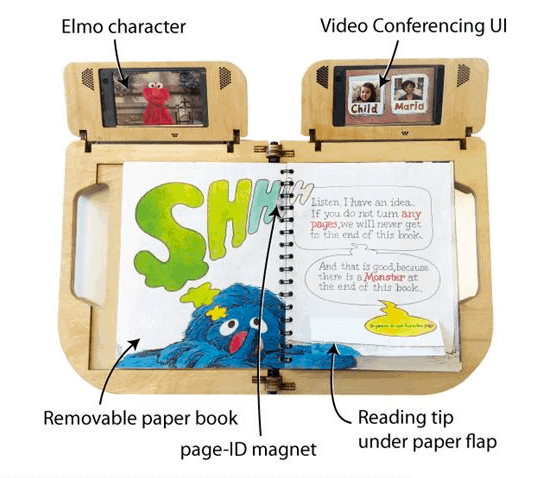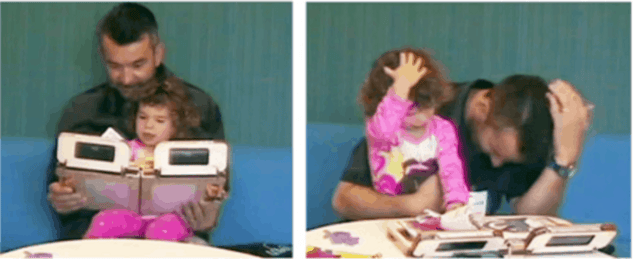Wizzle, a kazoo-like thingy
What is a Wizzle? They are kazoo-like trumpets with a giggly tube inside.
Blow in or out to make fun kazoo noises or shake it for a fun giggly
horn like sound. Loud, zany and fun!
What is a Wizzle? They are kazoo-like trumpets with a giggly tube inside.
Blow in or out to make fun kazoo noises or shake it for a fun giggly
horn like sound. Loud, zany and fun!
Hayes Raffle, Rafael "Tico" Ballagas, Glenda Revelle, Koichi Mori, Chris Paretti, Mirjana Spasojevic
| |
Pop Goes The Cell Phone confronts the challenge that very young children experience the world largely in the “here and now,” and asynchronous messaging is, by definition, neither here nor now. A jack-in-the box toy, Toaster, uses a mobile phone for children to playfully take and share electronic media. Orange Toaster allows children to create and share self-portraits; Family Toast allows children to browse family photos with physical tokens, and shares their self-portrait reactions with remote family members; Play with Elmo allows children and distant adults to asynchronously share playful video messages. Download the research paper. | |
![]()
Hayes Raffle, Rafael “Tico” Ballagas, Glenda Revelle, et al., in Collaboration with Sesame Workshop

Family Story Play supports grandparents to read books together with their grandchildren over the Internet. Story Play improves communication across generations and over a distance, and to supports parents and grandparents in fostering the literacy development of young children.
The interface encourages active child participation in the book reading experience by combining a paper book, a sensor-enhanced frame, video conferencing technology, and video content of a Sesame Street Muppet (Elmo). These features improve child engagement in long-distance communication. Story Play also encourages dialogic reading styles that are linked with literacy development.
Family Story Play leverages a synergy between young children’s education—in this case, a rich shared reading experience—and communication with long-distance family. Our goal is to create new kinds of toys and tools that support creativity, learning, and family togetherness.

As a researcher At the MIT media lab I have been pursuing my vision to create interactive toys that people bring to life through play and learning. My expertise is in designing products that navigate the boundary between the physical and digital worlds, building on over ten years inventing and bringing innovative designs to market. My work involves conceiving new ideas for interactive media, and helping manage prototyping, testing and marketing of those ideas. My goal is to reinvent children’s interactive technologies to reflect children’s passions, creativity and encourage collaboration. |
Topobo is a 3D constructive assembly system with kinetic memory, the ability to record and playback physical motion. You can build a dog with Topobo, wiggle its body around with your hands and teach it to walk. The dog will then repeat your motions repeatedly. The same way kids can learn about static structures playing with blocks, they can learn about dynamic structures playing with Topobo. In this video interview with the Science Channel I explain the system in more detail. Topobo integrates all of the things I love about design – a clean and emotionally engaging concept, strong aesthetics, clear interaction and enough flexibility for the user to put their own personality into the product. Furthermore, designing Topobo has been an amazing collaboration, and I have been able to learn skills from product designers, graphic designers, electrical and computer engineers, educators and kids. We have tested Topobo in classrooms with kids ages 5-14 throughout the design cycle. These interactions were enlightening for us, giving us insight how others made meaning of the system, seeing people build and animate creations we’d never imagined, and getting feedback about how to improve Topobo in future iterations. To our delight, both 2nd and 8th graders told us they thought Topobo was designed for them! |
| Our work led to four peer-reviewed conference papers, an ID Magazine Design Distinction, a Prix Ars Electronica Honorable Mention for interactive art, and numerous international shows in art, design and education. The system has also had a mature design cycle. In 2004 I received a Microsoft iCampus grant to conduct longitudinal research studies, and pursued a complete two-year redesign of the system including production manufacturing in Hong Kong. My experience conducting design work at the Chinese factory has given me a deeper understanding of the full design and manufacturing cycle of interactive media products. |
Jabberstamp is the the first tool that allows children to synthesize their drawings and voices. To use Jabberstamp, children create drawings, collages or paintings on normal paper. They press a special rubber stamp onto the page to record sounds into their drawings. When children touch the marks of the stamp with a small trumpet, they can hear the sounds playback, retelling the stories they have created. Children ages 4+ use Jabberstamp to embed names, narratives, characters’ voices and environmental sound effects in their original drawings. Children’s compositions help them communicate their stories with peers and adults, and allow them to record and situate stories in personally meaningful contexts before they have mastered writing. |
| I originally stumbled upon toy invention through an artist internship that helped shape my undergraduate sculpture studies at Yale. One summer I helped artist Michael Joaquin Grey conceive and design a new building toy called ZOOB, a haptic modeling system that allows people to reflexively learn about biological structures like bones and molecules. I later helped Michael start up a design and manufacturing company to bring ZOOB to market. ZOOB was a great success—we did over $3M in our first year, and won a number of awards including Dr. Toy Best Toy, Toy of the Year and ID Magazine Design Distinction for consumer products. Over the next several years I directed the company’s internal design department, overseeing all of the company’s print and product design. |
| After ZOOB, my independent art and design work led me to the MIT Media Lab, where I joined the Tangible Media Group to develop my technical and conceptual skills developing electronic media. My early work at MIT was driven by an ambition to create new product designs that engage people’s kinesthetic sense and love of play to support communication, entertainment and learning. |
Super Cilia Skin is a literal membrane separating a computer from its environment. Like our skin, it is haptic I/O membrane that can sense and simulate movement and wind flow. Our intention is to have it be universally applied to sheath any surface. As a display, it can mimic another person’s gesture over a distance via a form of tangible telepresence. A hand-sized interface covered with Super Cilia Skin would produce subtle changes in surface texture that feel much like a telepresent "butterfly kiss." Our extensive design studies spanned dozens of physical and electronic prototypes and led to a technical paper in CHI and a full journal paper in "Textile: The Journal of Cloth and Culture" (Berg 2004). The investigation focused on the haptics and scale: as a product, Super Cilia Skin is a "touch telephone." As wallpaper or carpet, we considered the potential for actuated, telepresent interior design. At the tectonic scale, sheathing tall buildings, the interface assumes dual roles as billboard size display or as wind-driven electromagnetic power generators. |
The You’re In Control system uses computation to enhance the act of urination. Sensors in the back of a urinal detect the position of impact of a stream of urine, enabling the user to play interactive games on a screen mounted above the urinal. In order to allow men and women to publicly interact with YIC, we built a customized game controller that can be strapped around the waist and pressurized to create a stream of water. Players can toggle between the "Flying Hamsters" and "You’re A Nation" games by flushing the urinal. It really is a pissing contest! |
About fifty years ago my grandfather invented a polymer clay called Sculpey and reinvented how children can create and express themselves. His life as an inventor and entrepreneur inspires me to imagine how electronic toys can be more than flashy gadgets or media conduits, and actually amplify children’s creativity, expression and playful learning. +Hayes Raffle
|

ZOOB® is the first construction toy based on things that grow, from DNA to dinosaurs. Hayes worked with inventor Michael Grey to conceive and design the initial system. As employee #6 at Primordial, LLC, Hayes helped oversee all aspects of production design, including helping build and manage a design team to create product designs, packaging designs, and videos. The team won an ID Magazine award in the 45th Annual Design Review in Consumer Products and the toy has been popular for over twenty years.

